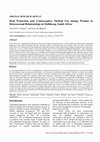Papers by GODSWILL OSUAFOR
African journal of drug and alcohol studies, 2019

African journal of drug and alcohol studies, 2017
Religiosity modulates many aspects of human behaviour. However, there is paucity of empirical stu... more Religiosity modulates many aspects of human behaviour. However, there is paucity of empirical studies examining the protective effects of religiosity on alcohol and substance use among first-year students in South African universities. This study therefore assessed the protective effects of religiosity on alcohol and substance use among first-year students in a South African university. A total of 348 first-year students were purposively sampled for the study which lasted for 30 days. Results revealed that alcohol consumption, tobacco smoking, use of cannabis and any substance were 60.1%, 31.5%, 23.3%, and 36.9% respectively. High religiosity scores conferred protectives effects on alcohol consumption, (OR=0.33, p<0.01), tobacco (0.23, p<0.01), and on the use of any substance (0.38, p<.021). Being a male student, residing with parents and living in an urban area were associated with increased odds of alcohol use. Age and fathers' educational level were predictive of likelihood to use tobacco. The use of marijuana was associated with being a male student. Use of any substance was associated with being a male student and residing in the urban area. The current findings suggest that religiosity had restrictive role on alcohol consumption and substances use. Parental factors underscored the use of substances among the study population.
African Journal of Reproductive Health, Nov 6, 2021
Aspects of the interrelation between hypertension and insulin resistance: A preliminary study. Ba... more Aspects of the interrelation between hypertension and insulin resistance: A preliminary study. Background: It is well known that some genetic factors and dietary factors, such as

The aim of this study was to examine the pattern of substance use among university students in So... more The aim of this study was to examine the pattern of substance use among university students in South Africa. A cross-sectional study of randomly selected 416 students was conducted. Data were analysed using descriptive statistics and binary logistic regression. The result of the study indicated that current alcohol use was reported by 67.5%, Cigarette, 21.4%, cannabis, 17.3% and glue 2.9%. Alcohol consumption was associated with sex, age, religious affiliation, home language, family influence, and substance experimentation. Sex and substance experimentation were predictors of cigarette smoking. Cannabis use was associated with respondent's sociocultural group and family influence. There is need to strengthen the family structure of homes as present substance use is rooted in family influences. Educational programmes that emphasise the dangers of experimenting with substance to young people may have great potential in minimizing substance use.

South African Journal of Psychiatry, 2021
Background: School absenteeism has been studied in detail in relation to health risk behaviours u... more Background: School absenteeism has been studied in detail in relation to health risk behaviours using cross sectional studies. Aim: The aim of this longitudinal study was to examine the association amongst alcohol, drug use and high-school learners' absenteeism. Setting: This study was set in the Western Cape. Methods: Data were collected at three separate time points from 2950, 2675 and 2230 grade 8 learners aged 13-18 years old on school absenteeism, alcohol and drug use and sociodemographic characteristics. Associations between school absenteeism, alcohol and cannabis and sociodemographic factors use were examined using descriptive and chi-square analyses. Binary logistic regression was performed using generalised linear mixed model analyses. Results: Results revealed that 9.3% of the learners were absent for 2 weeks in the 15 weeks of the school year. Alcohol consumption (X 2 = 34.1, p < 0.001; odds ratio [OR]: 1.64 (1.38-1.94), p < 0.001) and smoking cannabis (X 2 = 49.9, p < 0.001; OR: 2.01 (1.65-2.45), p < 0.001) were associated with school absenteeism at bivariate and multivariate analyses. Furthermore, alcohol (OR: 1.42 (1.06-1.89), p < 0.05) and cannabis (OR: 1.57 (1.11-2.22), p < 0.05) use remained robust in predicting learners school absenteeism after adjusting for age, sex and socioeconomic status. Conclusion: These findings suggest that alcohol consumption and smoking cannabis are contemporary factors associated with school absenteeism. Therefore, interventions to ensure learners' consistent attendance to school should integrate prevention of alcohol and cannabis use.

African journal of drug and alcohol studies, 2016
The aim of this study was to examine the pattern of substance use among university students in So... more The aim of this study was to examine the pattern of substance use among university students in South Africa. A cross-sectional study of randomly selected 416 students was conducted. Data were analysed using descriptive statistics and binary logistic regression. The result of the study indicated that current alcohol use was reported by 67.5%, Cigarette, 21.4%, cannabis, 17.3% and glue 2.9%. Alcohol consumption was associated with sex, age, religious affiliation, home language, family influence, and substance experimentation. Sex and substance experimentation were predictors of cigarette smoking. Cannabis use was associated with respondent’s sociocultural group and family influence. There is need to strengthen the family structure of homes as present substance use is rooted in family influences. Educational programmes that emphasise the dangers of experimenting with substance to young people may have great potential in minimizing substance use. Keywords: pattern, psychoactive, substan...

African Journal of Gender, Society and Development (formerly Journal of Gender, Information and Development in Africa), 2021
The autonomy of women in sexual and reproductive decision-making within family settings may repre... more The autonomy of women in sexual and reproductive decision-making within family settings may represent gender equality and reproductive health relief. The theory of gender and power was used to identify socio-economic factors that influence women’s decision-making on sex and family size. A survey of 568 married and cohabiting women was conducted in Mahikeng, South Africa in 2012. Structured questionnaires were used in data collection and were analysed using descriptive statistics and binary logistic regression methods. The Findings of the study revealed 60.7% and 70.1% women participate in decisions on sex and on size of family respectively. Perceptions husbands had the right to sex, experience sexual violence, being in religious and traditional unions had negative impacts on women’s sexual autonomy. Employed women and reporting choosing of partners significantly enhanced women’s sexual autonomy. Traditional union, experienced of sexual violence sex, perceptions that husbands had rig...

African Journal of Reproductive Health, 2017
South African new reproductive health policies have given weight to dual protection as a public h... more South African new reproductive health policies have given weight to dual protection as a public health intervention against unintended pregnancies and sexually transmitted infections. However, studies of dual protection have remained scanty and under researched in South Africa. This situation has left the reproductive health policy makers clueless about salient strategies to promote dual contraceptive method use. A survey of 568 women in steady relationships aged 15-49 was conducted in Mahikeng Municipality. Using multivariate logistic regression independent predictors of contraceptive method use were examined and presented as odds ratio and 95% confidence intervals. Sixteen percent of the women were currently protecting against both unintended pregnancies and infectious diseases while 40% were protecting against unintended pregnancies only. Age, occupation, ever discussed condom use with partner; home language and religion were the independent predictors of dual method use. Non-barrier method use was associated with age, home language, religion, and duration of union. The study concludes that educative and enlightening programs that emphasize women's employment and communication about condom use may be specifically helpful in promoting dual method use.

Journal of Population Research, 2017
Married and cohabiting women have been neglected in the promotion of condoms as the most effectiv... more Married and cohabiting women have been neglected in the promotion of condoms as the most effective prevention method of sexually transmitted infections (STIs) and HIV. As a result, HIV prevalence is increasing in this population group in high HIV prevalence settings. The study assesses the prevalence of and identifies the predictors of consistent use of male condoms among married and cohabiting women, and examines its implications for HIV transmission. The data used were obtained from a cross-sectional survey on sexual and reproductive health conducted among women aged 18-49 years of age in Mahikeng Local Municipality in 2012 using mixed methods. A structured questionnaire and in-depth interview guide were used to collect quantitative data from 568 and qualitative data from 33 married or cohabiting women. The data were analysed using logistic regression and thematic content analysis methods. The results show that only 16.2% of the women consistently used condoms. Women having no and 1-2 surviving children, educated women, women in relationships in which most sexual decisions were jointly made with husbands/partners, women having high risk perceptions of STIs and HIV infection and women who negotiate condom use with and know the HIV status of their husbands/partners were significantly more likely to have consistently used condoms. However, women who perceived that condoms reduce sexual pleasure, feared they would be blamed for infidelity by husbands/partners, trusted that their husbands/partners were faithful and feared condoms could lead to relationship instability used condoms inconsistently. We conclude that the prevalence of consistent use of condoms by married and cohabiting women in the study is low, indicating that promotion of condoms among married or cohabiting women is & Godswill N.
African Journal of Primary Health Care & Family Medicine, 2018
In the version of this article published earlier, the third author's affiliation was misstated. T... more In the version of this article published earlier, the third author's affiliation was misstated. The affiliation of Natal Ayiga is hereby updated and corrected to the 'Department of Social Work, Kabale University, Uganda'. The author sincerely regrets this error and apologises for any inconvenience caused.

Sexuality & Culture, 2016
Risky sexual behaviour continues to be the main means through which sexually transmitted infectio... more Risky sexual behaviour continues to be the main means through which sexually transmitted infections (STIs) and HIV are spread in South Africa. However few studies have assessed risky sexual behaviour among married and cohabiting women in this high HIV prevalence country. The aim of this study was therefore to assess the prevalence and identify the predictors of risky sexual behaviour among married and cohabiting women in Mahikeng Local Municipality where HIV is generalized. The study used cross-sectional mixed methods data obtained from 568 women responding to a survey and 33 women participating in in-depth interviews in 2012. All the women were aged 18-49 years, married or cohabiting and were residing in rural and urban areas of Mahikeng Local Municipality at the time of the study. The data was analyzed by the use of the Chi square statistic and a parsimonious binary logistic regression model, and the thematic content analysis method. The study found that 4 in 10 of the women experienced risky sexual behaviour, which was significantly predicted by being in marriage or cohabitation for \5 years, having a partner working in agriculture, government and mining sectors, having sex to achieve motherhood, having the perception by the women that they were unlikely to contract STIs, having the belief that partners have the right to use force to obtain sex and having partners who were unwilling to use condoms. All the above predictors were exacerbated by culturally sanctioned gender inequality and structural factors. The findings suggest that risky sexual behaviour is prevalent among married and cohabiting women in the study area which has serious implication for the marital transmission of STIs and HIV. We suggest interventions that enhance gender equality in sexual decisions and initiatives that encourage men to change their sexual beliefs and values.

Aspects of the interrelation between hypertension and insulin resistance: A preliminary study. Ba... more Aspects of the interrelation between hypertension and insulin resistance: A preliminary study. Background: It is well known that some genetic factors and dietary factors, such as excessive salt intake and excessive caloric intake (resulting in obesity) are risk factors for hypertension. Fifty percent of all hypertensive patients are also insulin resistant. Both hypertension and insulin resistance are again risk factors for other cardiovascular diseases such as atherosclerosis and heart failure. The nature of the association between hypertension and insulin resistance has not been clearly elucidated. Spontaneously hypertensive rats are the ideal models to study the aspects of the relationships between hypertension and insulin resistance. Models of high-fat feeding induce obesity, hypertension and insulin resistance and are thus used extensively to study hypertension because these models closely mimic some of the renal and cardiovascular changes found in human hypertensive patients. The present study was initiated to evaluate if insulin resistance will develop within 6 weeks in a model of high-fat diet induced hypertension and if so, to determine whether captopril will affect the presence of insulin resistance.

African Population Studies, 2014
Husbands continue to be the greatest source of sexually transmitted infections including HIV to t... more Husbands continue to be the greatest source of sexually transmitted infections including HIV to their wives. Using a survey of 568 respondents and 33 in-depth interviews, this study examined the attitudes of women in marital and steady relationships towards sexual control in Mahikeng. Data analysis using logistic regression showed that age, type of union, education, occupation, and number of living children were significantly associated with attitudes towards rejecting sex. Additionally, age, type of union, education, and number of living children were found to be significantly associated with demand for sex. Qualitative data revealed that social-cultural factors influence the disposition of most women regarding demanding or rejecting sex from their husbands. Their attitudes to sexual control are intertwined with cultural, religious belief and perception that husbands have sexual right over their wives. Women empowerment initiatives should continue to be considered as a means to assist women to control their sexuality.
International Journal of Epidemiology, 2015











Uploads
Papers by GODSWILL OSUAFOR